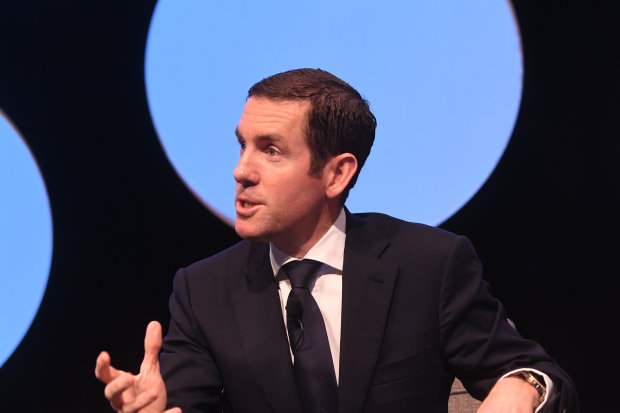Clouds hang over Greensill’s future

Cheap and abundant capital has been crucial to Greensill Capital’s supply chain financing product. But where too much capital exists, risks will emerge.
A year can be a long time in business.
As the latest news on the clouds hanging over Australian-born finance group Greensill Capital bounces from New York to London and back to Australia, Chanticleer’s mind was taken back 12 months to when its founder, Lex Greensill, jokingly questioned the sorts of watering holes your columnist frequented.
We were on stage at The Australian Financial Review’s annual business summit and Greensill was looking to get square, in the nicest possible way.

A few weeks earlier, I’d suggested the model of supply chain financing that Greensill Capital had developed – whereby a business borrows money from a financier such as Greensill Capital to pay their suppliers early, but at a discount – didn’t pass the pub test, as it represented a way for big companies to take advantage of small ones, all for a gain that is pretty minuscule to both sides.
Lex Greensill very respectfully disagreed. “I don’t know what pubs you drink at,” he said with a smile.
Greensill saw supply chain finance as helping cashflow-poor small businesses get access to money that is rightfully theirs by harnessing the power of the bond market in a way that hadn’t been done before.
Greensill Capital raises money by packaging up the loans it makes to businesses to pay their suppliers and then selling these packages of loans in bond markets.
It makes money on the arbitrage between the discount suppliers are prepared to accept to be paid early and what Greensill Capital pays for funding in bond markets.
A year on, I still think we were both right. Greensill had created an innovative financing model that could, in the right circumstances, be a tool to improve cashflow for both the customer and the supplier.
But it is a model that can accentuate a power imbalance between two parties in some circumstances.
Such philosophical debates are the last thing Greensill will be worried about right now, of course.
On Monday night, banking giant Credit Suisse froze $US10 billion ($13 billion) worth of investment funds linked to Greensill Capital. These are a key source of funding for Greensill Capital – it is through these funds that Greensill Capital sells the packages of loans it creates.
Credit Suisse had “suspended the redemptions and subscriptions” in the funds “to protect the interests of all investors”, the investment bank said in a note to investors.
“A certain part of the [funds’] assets is currently subject to considerable uncertainties with respect to their accurate valuation,” the bank said.
Multiple reports suggest Credit Suisse’s concerns centre on loans made by Greensill Capital to the GFG Alliance, the empire of British steel magnate Sanjeev Gupta. Greensill Capital’s exposure to Gupta’s group was also reportedly behind action by Germany’s financial regulator, BaFin, to get a Greensill Capital subsidiary to reduce its exposure to Gupta’s businesses.
One lawyer experienced with supply chain finance and its various derivatives said there were many risks inherent in such products, but the biggest is that lenders and banks who finance these transactions struggle to analyse and quantify the underlying credit and operational risk, partly because the structures involved are very complex.
Greensill Capital said in a statement it acknowledged “the decision by Credit Suisse to temporarily gate Supply Chain Finance Funds dealing in Greensill-sourced assets”.
“We remain in advanced talks with potential outside investors in our company and hope to be able to update further on that process imminently,” it said.
Reports suggested Greensill Capital was in talks with US private equity group Apollo Management about a potential deal.
An Australian spokesman emphasised on Tuesday morning that the group remains open for business and daily operations are unaffected.
As Greensill Capital makes clear, this is a fast-moving situation and there is likely to be a lot to play out.
Regardless of where it goes, though, it’s hard not to see Greensill Capital’s current struggles as a symptom of what well-respected Macquarie strategist and author Viktor Shvets has described as the financialisation of everything.
As Shvets argues, capital is supposed to be scarce in a capitalist economy. But over the past 50 years, financialisation has created an abundance of capital.
“We are drowning in capital. It’s not evenly distributed, it’s not fairly distributed, but nevertheless there is no shortage of capital,” Shvets said on a podcast last year with interest.co.nz. “In industrial economies, capital was created in line with economies. Today we’re creating four or five times more capital than economies require every year.”
The combination of this abundance of capital and the ultra-low interest rates seen since the global financial crisis means this capital has found its way into places it never needed to go before.
Greensill Capital’s product is an example. For centuries there has been no major need to finance the agreed payment terms between a supplier and their customer. But today, the capital is available and there’s a small profit to be made, so an industry opens up.
There’s nothing wrong with that, of course – you could say that’s disruptive innovation.
But we also need to accept that the financialisation will invariably mean abundant capital ends up in some risky places – both niche financing products and in the hands of borrowers where, in the words of Credit Suisse, “considerable uncertainties” lie.
No comments:
Post a Comment